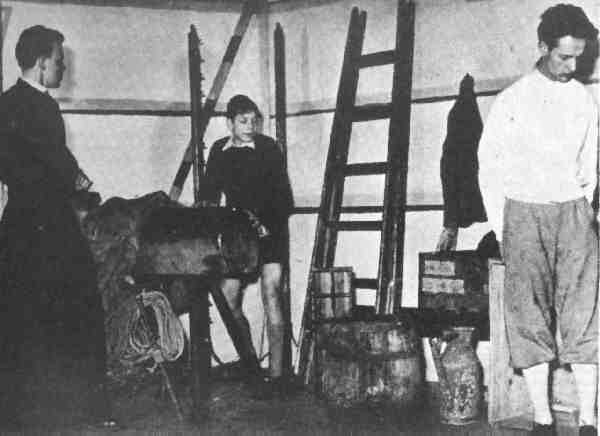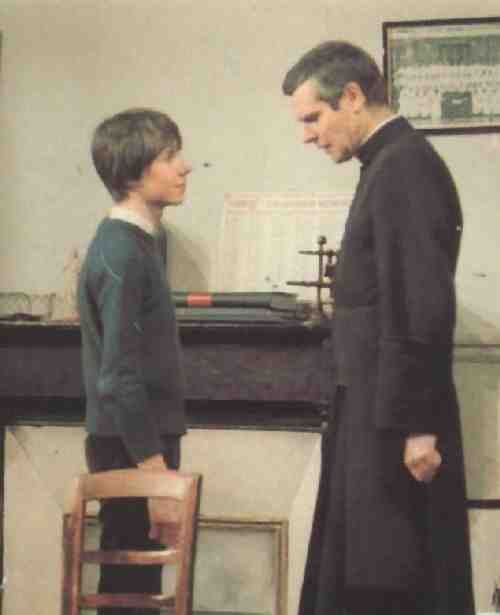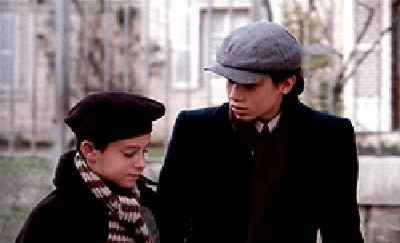
Stage Productions: La Ville Dont le Prince est un Enfant

Figure 1.--This is a scene from L'Avant-Scène Théâtre Special Montherlant 1967:
First integral performance in January 1953 by the student group "Belles-Lettres" in
Geneva (Switzerland): R. Tender (Father de Pradts), V. Altman (Serge Soubrier), R.
Gillioz (André Sevrais). One can see Soubrier is clad in short pants. It was common for French boys at the time to wear shorts at 14, although the student who plays the role seems
older than 14. Sevrais wears knickers.
|
"La ville dont le prince est un enfant" ("The Town whose Prince is a Child") is a notable French play set in a boarding school and showing school clothes during the inter-war cperiod.
Author
The play waswritten by Henri de Montherlant in 1951. Henri de Montherlant (1896-1972) is a noted French playwrite, born in Paris. He was accepted into the French Académie française in 1960. Montherland his spent his teen years in Sainte-Croix de Neuilly (Neuilly is the most posh residential town aside Paris near the Bois de Boulogne). In 1911 he was in
the 1st form, the year before the Baccalauréat year when he saw a piece of
theater played by the 3rd form students. As the name of the school tells us, it was a
Catholic school.
The Setting
The action takes place between the two World Wars (1919-1939) in Paris (Auteuil)
(one of the most posh districts with Neuilly), in a catholic college, about at
the end of March. Father de Pradts, 35, master of studies is too over-indulgent
with an unruly pupil, Serge Souplier, 14 years old. A friendship develops between Souplier and André Sevrais, a philosophy student, 16 years old. De Pradts looks very
unfavorably upon this friendship and will strive to separate Souplier and Sevrais.
Finally Souplier is sacked from the college but the Father Superior excludes also
Sevrais from the college and gives his reasons to de Pradts in a long scene which
is one of the most acclaimed of Montherlant's plays.
Reception
"La ville" written in 1951 and published the same year achieved great success.
However Montherlant refused the authorization to stage the piece to a lot a
people, including catholic theatre amateurs and not less than sixteen professional
theatres. Some years later the authorization was given to amateurs theatrical companies in Geneva (Switzerland), Liege (Belgium) and Amsterdam (Netherlands). Finally "La ville"
was performed for the first time by professional actors in Paris in 1967.

Figure 2.--First professional performance in 1967. Souplier is clad accordingly to the second version in long pants. Note the sweater: the sleeves at the elbows are very worn and stretched as in real life.
|
Versions
Two versions of the piece of theatre exists:
Original
In the original version written in 1951, Souplier is in fact named Soubrier.
Soubrier was changed to Souplier in the second version on the request of an
homonym. Montherlant describes Souplier in short pants, sweater and kneesocks as
should have been clad a pupil of 14 years old in a Paris catholic college between the
World Wars. He even specifies that one of the stockings has falling down.
Second version
In the second version, written in 1967, Souplier is depicted as wearing long pants
and sweater although the action still takes place in the same place and same period of
time. This time, instead of the fallen kneesock, a lace of the shoes is too long
and sags. In both versions Montherlant specifies Souplier and Sevrais's clothes as casual
and worn.
School Details
Sevrais and Souplier are from two different divisions (the older are separated from the
younger). Sevrais is a day students (the only one of his division). Souplier is a member of the Schola, Sevrais a member of the Académie. There is also a congregation.
Parents and collège are 2 very different worlds and there is no interest to meddle
them (from the point of view of the priests).
Movie
The play has also been produced as TV movie. The TV film is quite faithful to the
piece of theatre. A French contributor to HBC has provided the following synopsis.
"L'histoire se déroule à Paris, entre deux
guerres, dans un collège catholique. Les
amitiés entre élèves de sections
différentes sont absolument interdites.
Ce n'est un secret pour personne au collège
que l'Abbé de Pradts s'intéresse
particulièrement à Souplier, élève de
troisième.
C'est le type de gosse à histoires. En un
an, il a été à deux reprises sur la liste
des élèves à renvoyer et deux fois Monsieur
l'Abbé de Pradts a obtenu de Monsieur le
Supérieur que son nom fût effacé.
L'Abbé de Pradts est contrarié par
l'influence qu'un autre élève exerce sur le
petit Souplier. Il s'agit de Sevrais, élève
brillant de philosophie, à qui, jusqu'à ce
jour, on n'a rien eu de précis à reprocher.
Sa loyauté et sa générosité sont estimés au
collège. Il vient d'ailleurs spontanément
parler à l'Abbé et lui proposer de " rompre
" avec son camarade.
Plutôt que d'écarter Sevrais, l'Abbé de
Pradts mise sur sa loyauté et l'autorise à
continuer de voir Souplier, avec la
promesse solennelle que leurs relations
seront irréprochables. Au collège,
l'association Sevrais-Souplier a quelque
chose d'incroyable, d'autant qu'elle est à
présent officielle : " L'as du collège et
le voyou du collège ". Le lendemain, après l'étude, Sevrais et Souplier se donnent rendez-vous à la resserre. Ils font le serment que leur amitié sera toujours ce qu'elle est
aujourd'hui. Ils font le " serment du sang".

Figure 3.--In April 1997, after theatre performances in Paris, a TV film was shot and aired twive on France 2, one of the French public channels, and Arte (French-German public
channel). Curiously enough for the theatre performance and the film, Souplier came
back to short pants!
|
Lorsque l'Abbé de Pradts arrive à la resserre, Souplier prend peur, ferme la
porte à clé et se cache dans le désordre de l'endroit. Pour sauver son camarade,
Sevrais est contraint au mensonge. L'Abbé n'est pas dupe et, après une fausse sortie,
surprend Souplier. Sevrais, malgré lui, est
pris en flagrant délit.
L'Abbé a enfin ce qu'il veut : un éclat
public, le renvoi de Sevrais, l'amitié
brisée des deux enfants et ... Souplier.
C'est alors l'affrontement entre l'Abbé de
Pradts et l'Abbé Supérieur. Ce dernier
annonce, à son tour, le départ de Souplier.
Il dénonce les méthodes de l'Abbé qui avoue
qu'il ne croit pas en Dieu mais en l'être humain. Le Supérieur demande à ce prêtre
athée, qui n'a pas aimé une personne mais un visage, de renoncer tout à fait à son
apostolat auprès du garçon. L'Abbé de Pradts accepte, non sans se révolter contre l'hypocrisie de la morale religieuse."
Christopher Wagner
histclo@lycosmail.com
Navigate the Boys' Historical Clothing Web Site:
[Return to the Main play page]
[Return to the Main theatrical page]
[Introduction]
[Chronology]
[Clothing styles]
[Activities]
[Countries]
[Biographies]
[Bibliographies]
[Contributions]
[Boys' Clothing Home]
Created: March 13, 2000
Last updated: March 13, 2000




